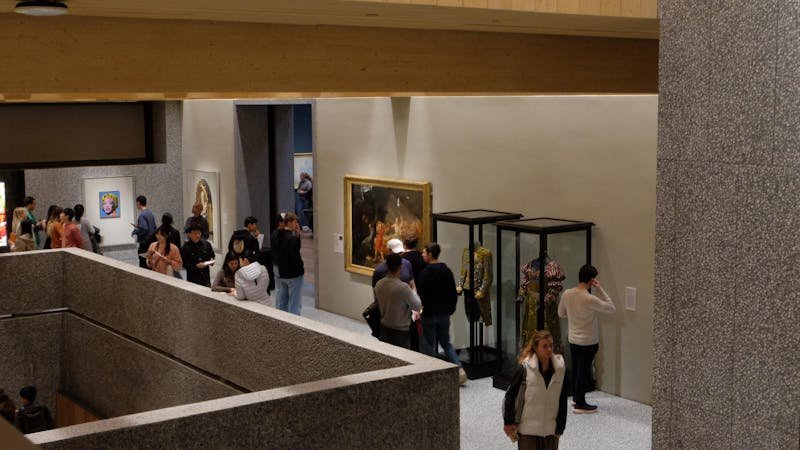In the Princeton University Art Museum, the art is everywhere — including in the hallways.
Upon ascending the Grand Stair of the museum up to the collections, the first pieces of art that many visitors see are those of the Orientation Gallery, which rings around the main staircase. Before even entering one of the seven pavilions dedicated to art, visitors pass through various hallways and transitional areas that double as compact galleries dedicated to art from the Islamic World, Latin America, Native North America, South Asia, and Africa.
The Orientation Gallery makes up one of the most unique areas of the whole museum, with works such as Andy Warhol’s “Blue Marilyn” (1962) juxtaposed against a long assortment of European Renaissance stained glass pieces.
“I like the mix of modern and ancient, the mix of time frames. I can’t think of another museum where I’ve seen that,” said Sherry Friend, docent at the Smithsonian’s National Museum of Asian Art, during a visit to the museum.
“The opening to the second floor of the museum is highlighting the fame of the museum, the fame of Princeton, and the caliber of art that they’re able to collect with their means,” said Madison Anderson ’27, an art history major and former member of the museum’s Student Advisory Board.
“Some galleries also serve as circulation spaces, we don’t see any of the gallery spaces in the building as ‘hallways,’” said Art Museum spokesperson Morgan Gengo.
Rather than simply connecting one gallery to the next, the circulation spaces present visitors with an unpredictable and diverse array of pieces. Tall glass cases above the Grand Hall, for instance, house a dizzying array of bowls, vases, and objects from a broad array of cultures. Meanwhile, the Cross-Collections Gallery, located just outside of the Asian Art Pavilion, builds Josiah McElheny’s “A Twilight Labyrinth (Alchemy)” (2019) into a wall near a Spanish alabaster carving of a knight from circa 1500.
But unlike areas like American, modern, and ancient Mediterranean art, which have dedicated pavilions, the museum’s African and Latin American art is largely showcased in the hallways.
“The museum, I know for a fact, has a very strong Latin American art collection … and the Latin American Gallery of Art is quite literally a corner,” Anderson told the ‘Prince.’
Perrin Lathrop GS ’21, Associate Curator of African Art at the museum, wrote in a statement that the “interstitial galleries emphasize ideas of cultural contact and exchange.” African and Latin American art galleries “are present throughout the museum and are inescapable,” she added.
“You can’t escape the fact that there will be art in that hallway,” Anderson said. “You’re going to have to pass by it, so why not look?”
Before the museum’s renovation, European, American, and contemporary art dominated the main upstairs floor, while non-Western art was placed in the downstairs galleries, where there were fewer visitors.

“The new museum, by putting art on the same physical level, helps convey that all art is important, it’s valuable,” said Annemarie Iker GS ’24, a scholar of modern art.
“The African art galleries have increased in size by some 700% from the previous building and are strategically located adjacent to the galleries for art of the Islamic world and the ancient Mediterranean,” Lathrop added.
Many of the pieces on display in the African art collection are attributed to an “Artist unrecorded,” a label that Lathrop wrote “recognizes the individuality of the person who created the work, before providing information about their culture and geographic origin.”
The attribution “serves as a corrective to the ways that the international circulation of their work, especially during the colonial era, erased their individuality,” Lathrop wrote.
Similarly, the Latin American and North Native American art galleries, located by the entrance to the American art pavilion, include many ceramic figures, vessels, and objects by artists that are unidentified, such as the “Model yaakw (canoe)” (before 1882). Most modern art from the cultures showcased in the transition spaces, however, is located in the Modern and Contemporary art pavilion.
“I’m not sure how much of this at the time people would have thought of as art,” Friend said, adding that the frequency of unnamed artists for certain cultures may be a consequence of the blurred line between art and product.
From iconic paintings of mythological and historical scenes to obscure Attic and ceramic Olmec pottery, the museum’s transitional spaces have much to offer. Despite not having their own dedicated pavilions, the African, South Asian, Native North American, and Latin American art scattered across the museum’s second-floor galleries provides visitors with the opportunity to learn about the cultural histories, traditions, and identities of artists from around the world.
Haeon Lee is a News contributor for the ‘Prince.’ She is from Brooklyn, N.Y. and can be reached at hl1389[at]princeton.edu.
Amaya Taylor is a News contributor for the ‘Prince.’ She is from Memphis, Tenn. and can be reached at at9074[at]princeton.edu.
Please send any corrections to corrections[at]dailyprincetonian.com.

